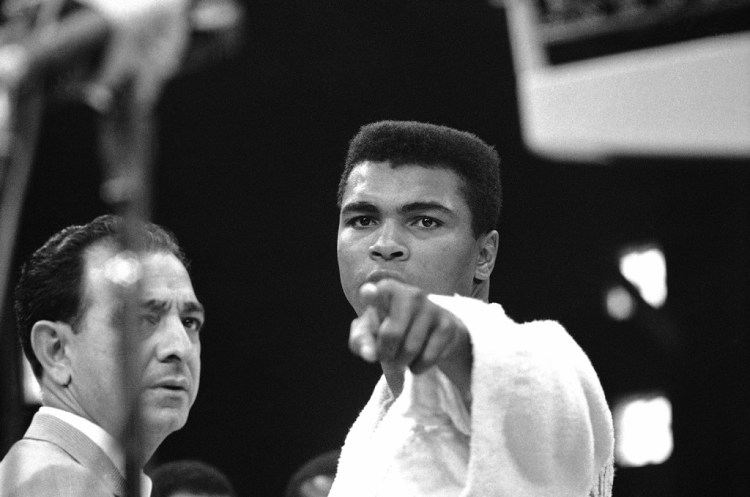A stained, faded white Everlast terry cloth robe worn one day in Lewiston more than half a century ago may prove among the costliest pieces of boxing memorabilia in history after going up for auction Monday.
What makes it so potentially valuable are two words embroidered in bright red thread across the back: Muhammad Ali.
Written in capital letters except for the final “i” with its tiny dot intact, the robe marked the first time the boxer originally known as Cassius Clay appeared in public with his new Muslim name showcased, a name still so controversial at the time that the Lewiston papers, along with many others, still referred to him as Clay in their stories.
The robe’s sellers claim that Ali wore the robe to a weighing-in at what is now the Androscoggin Bank Colisée – then known as the Central Maine Youth Center – where promoters had quickly erected a boxing ring in the middle of a hockey rink to host a heavyweight showdown between Ali and Sonny Liston.
The May 25, 1965, match had been scheduled for Boston but when state regulators looked askance, the promoter shifted the venue to Lewiston in a last-minute bid to preserve television royalty payments.
On old video footage, Ali is clearly wearing a robe that looks similar as he moves sprightly through a crowd to reach the ring ahead of the bout, which eventually ended in the first round with Liston sprawled on the canvas and Ali taunting him from above, an image captured in pictures still routinely reprinted around the world.
The robe is up for auction for 20 days through Goldin Auctions, a major sports collectibles seller. The minimum bid is $75,000.
Three years ago, when the robe first sold at auction, the winner paid almost $29,000 for it. But boxing-related collectibles have risen steadily in value so it may well be worth more.
The gloves worn by Ali and Liston that night, clearly a much hotter commodity, sold at auction a few years ago for nearly $1 million.
John Pradella, a 71-year-old Florida resident, said he wound up with the robe shortly after the bout.
An 18-year-old college freshman in Massachusetts, Pradella hung out at the Schine Inn in Chicopee, Massachusetts, to watch Ali’s training sessions in preparation for the fight. He became friendly enough with a boxer named Solomon McTier, one of Ali’s sparring partners, that the two went golfing together.
McTier eventually offered Pradella tickets to the heavyweight fight in Lewiston, but Pradella said he couldn’t attend because of a final exam.
According to a written account by Pradella, who could not be reached Monday, Ali and his entourage took a bus back to Chicopee after the fight to retrieve training gear.
Pradella said he ran into McTier, who hugged him and introduced him to Angelo Dundee, Ali’s famed trainer. McTier also explained that Pradella had been a big help but had missed the chance to see the bout.
According to Pradella, Dundee whispered something to McTier “and Solomon went on the bus and came out with a Muhammad Ali robe, which was hanging on a hook, and gave it to me.”
The Lewiston fight was a rematch of one a year earlier when Ali, then still calling himself Clay, defeated Liston in Miami.
Their rematch became infamous because many who watched it did not see the so-called “phantom punch” that left Liston out for the count less than 2 minutes into what many expected to be a slugfest.
The photographs depicting Ali standing over him and demanding he get up and fight helped cement the legend surrounding the match.
It all seemed so iffy that the state’s boxing commissioner, George Russo, seized the boxers’ gloves as part of an investigation. They remained in his family until they were sold a few years ago to a California collector.
Steve Collins can be contacted at:
scollins@sunjournal.com
Send questions/comments to the editors.


